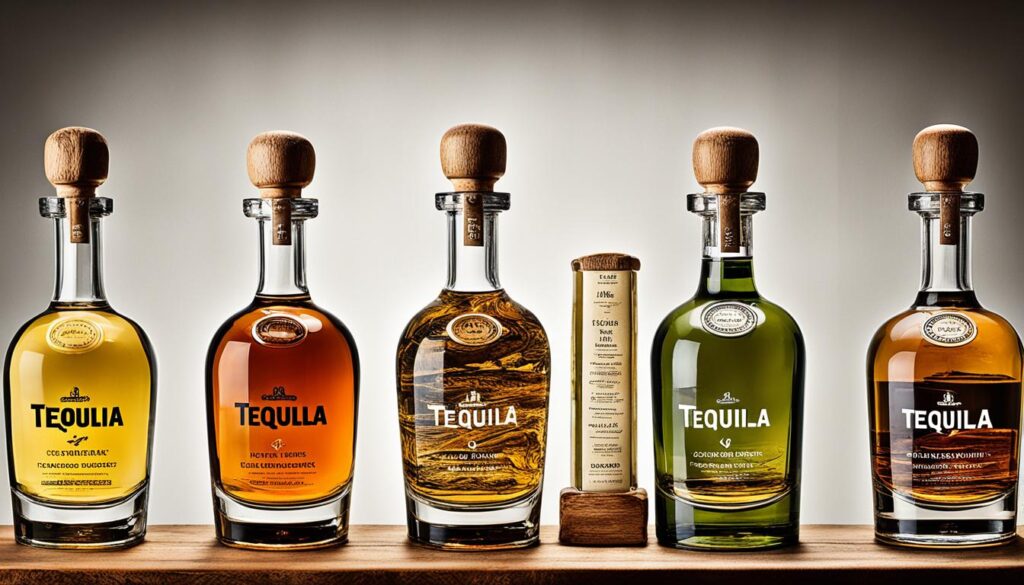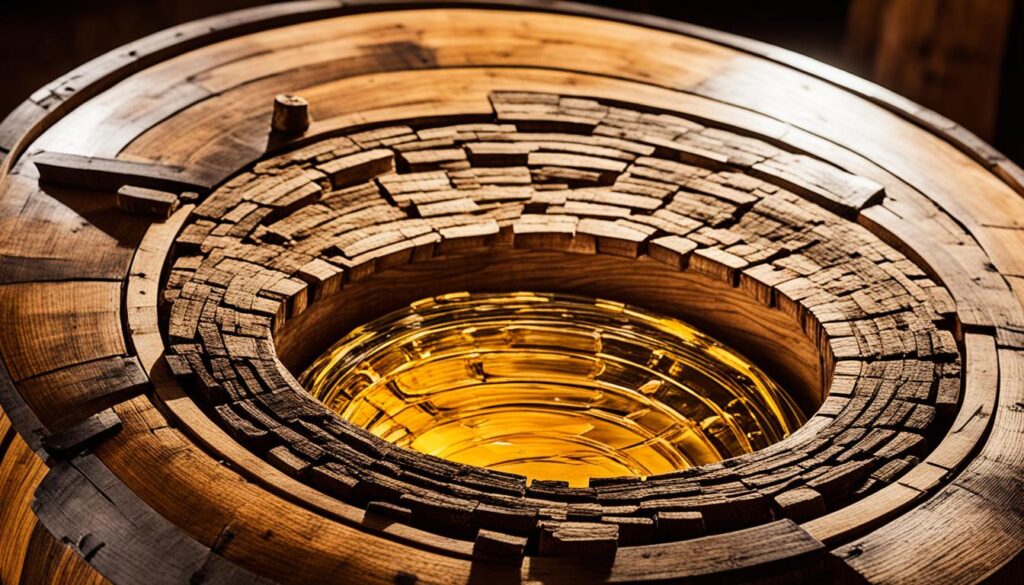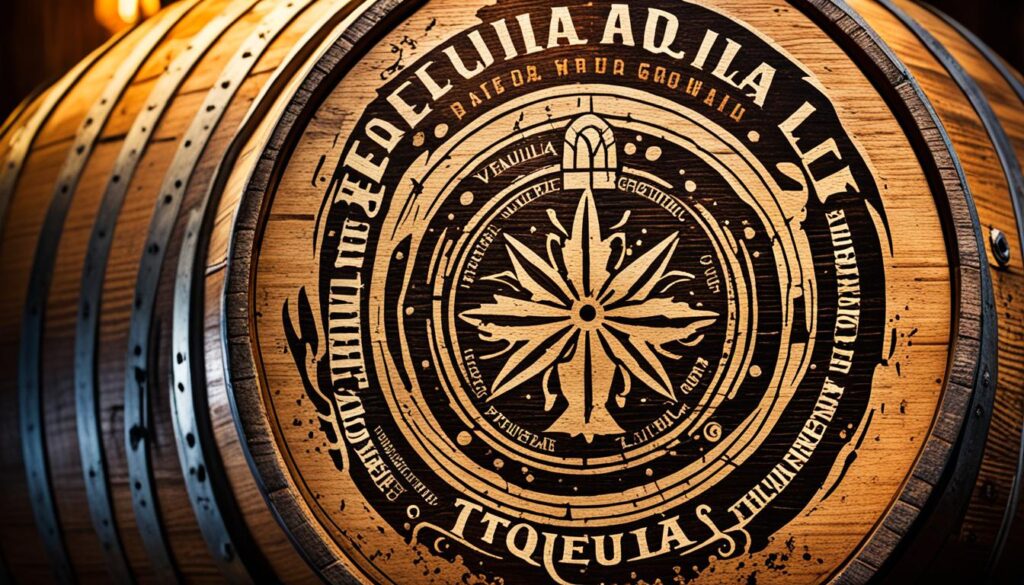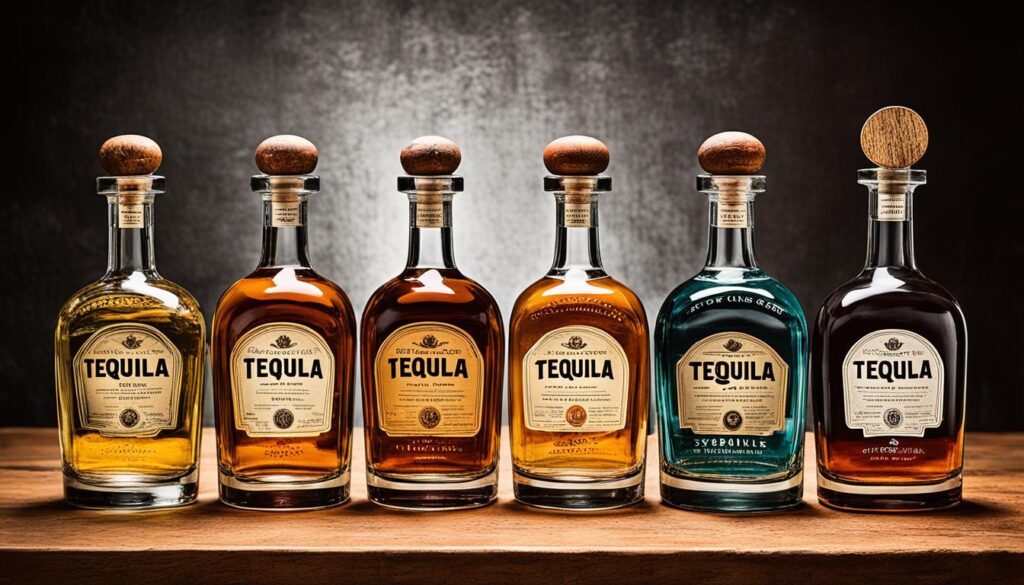Tequila, the beloved spirit cherished by enthusiasts around the world, holds within it a captivating secret. Nestled within its amber depths lies the artistry of tequila aging, an intricate process that gives birth to the unique flavors and characteristics we savor in every sip. But have you ever wondered what techniques are employed to bring forth these extraordinary qualities? How do the aging barrels transform the raw ingredients into the smooth and nuanced spirit we adore?
Join me on a journey through the intriguing realm of tequila aging techniques, where we will unravel the mysteries behind this time-honored craft. Together, we will delve into the origins, explore the influences of oak barrels, unearth the different aging levels, and uncover the innovations that push the boundaries of tradition. So, grab your glass and let’s embark on this tequila-infused adventure!
Key Takeaways:
- Tequila aging techniques contribute to the unique flavors and characteristics of the spirit.
- Oak barrels play a significant role in enhancing the flavors and smoothness of tequila.
- Tequila is classified into different aging levels, each offering a distinct taste experience.
- Barrel choice and aging time directly impact the flavor development of tequila.
- Terroir influences the aging process and adds regional characteristics to tequila.
Contents
- 1 The Importance of Aging in Tequila Production
- 2 Oak Aging in Tequila Production
- 3 Different Aging Levels in Tequila
- 4 The Influence of Barrels on Tequila Flavor
- 5 Techniques for Enhancing Tequila Aging
- 6 Innovations in Tequila Aging
- 7 The Significance of Time in Tequila Aging
- 8 Tequila Aging and Terroir
- 9 The Artistry of Tequila Aging
- 10 FAQ
- 11 Source Links
The Importance of Aging in Tequila Production
When it comes to tequila production, aging plays a vital role in developing the rich and nuanced flavors that enthusiasts know and love. This essential step allows the spirit to mature over time, resulting in a more complex and enjoyable drinking experience.
Traditional tequila aging methods have been honed through generations of craftsmen who understand the art and science behind flavor development. One of the key elements used in this process is the strategic use of oak barrels. These barrels not only act as vessels for aging but also impart unique flavors and characteristics to the tequila.
During the tequila maturation process, the spirit interacts with the wood, capturing its essence and steadily developing deeper flavors. The duration of aging can vary depending on the desired flavor profile and the quality of the tequila. Some tequilas may only spend a few months in oak barrels, while others are aged for several years to achieve a more refined taste.
“Tequila aging is a fine balance between time, craftsmanship, and the use of traditional techniques.”
The interaction between tequila and oak barrels results in the extraction of compounds such as tannins, vanillin, and lignins from the wood. These compounds contribute to the tequila’s flavor and aroma, adding notes of vanilla, caramel, and spices. The traditional tequila aging process exemplifies the craftsmanship and expertise that goes into creating a superior spirit.
The transformation that occurs during aging is remarkable. The raw intensity of youthful tequila mellows as it absorbs the flavors from the oak, resulting in a smoother, more well-rounded spirit. It’s this maturation process that allows tequila to reach its true potential and captivate the palate.
Understanding the importance of aging in tequila production unveils the dedication and mastery behind creating exceptional spirits. Whether it’s a young, vibrant blanco or a rich and complex aejo, the flavors developed through traditional tequila aging methods have become synonymous with the spirit’s identity.
By embracing the significance of aging, we can truly appreciate the craftsmanship and artistry that make tequila more than just a drink. It’s an experience that invites us to savor every sip and cherish the immense wealth of flavors that tequila has to offer.

| Tequila Aging Methods | Duration | Flavor Development |
|---|---|---|
| Blanco Tequila | Unaged or aged for up to two months | Fresh, vibrant flavors with prominent agave notes |
| Reposado Tequila | Aged for a minimum of two months but less than a year | Smooth and complex flavor profile |
| Aejo Tequila | Aged for at least one year | Rich and pronounced woody flavor |
Oak Aging in Tequila Production
Oak aging is a crucial step in the tequila production process, contributing to the development of complex flavors and the smoothness of the spirit. In this section, we’ll dive deeper into the tequila wood aging process and explore the various tequila resting techniques that give this beloved spirit its unique character.
When it comes to oak aging, tequila is typically aged in oak barrels made from American or French oak. These barrels provide the perfect environment for the spirit to mature and develop its distinct flavors over time. The tequila is carefully placed in the barrels and allowed to rest for a specific duration, absorbing compounds from the wood that contribute to its taste and aroma. Tannins and vanillin are just a few examples of the compounds that the tequila absorbs, resulting in a more nuanced flavor profile. The type of oak used and the length of the aging process can vary, creating different flavor profiles and complexities in the tequila.
To give you a visual representation of the oak aging process, here’s a table outlining the key differences between American oak and French oak:
| Oak Type | Characteristics | Flavor Profile |
|---|---|---|
| American Oak | – More fibrous and porous wood structure – Higher tannin content – Imparts flavors of vanilla, coconut, and caramel – Adds depth and richness |
Rich, sweet, and robust |
| French Oak | – Tighter grain and less porous wood structure – Lower tannin content – Adds subtle flavors of toast, spice, and dried fruit – Creates a more delicate and elegant character |
Subtle, elegant, and complex |
The duration of the resting period in the oak barrels is a crucial factor in determining the final flavor profile of the tequila. Shorter resting periods result in lighter, fresher flavors, while longer resting periods allow for greater interaction between the tequila and the wood, resulting in richer and more mature flavors.
It’s important to note that oak aging is not a one-size-fits-all approach. Each distillery may have its own unique methods and techniques, resulting in tequilas with distinct characteristics. The artistry lies in determining the ideal combination of oak type, resting duration, and other factors that bring out the best qualities of the tequila.
By understanding the intricacies of the oak aging process and the tequila resting techniques employed by distilleries, we can better appreciate the craftsmanship and skill that go into creating our favorite tequilas.

Different Aging Levels in Tequila
Tequila aging levels play a crucial role in the flavor development and characteristics of this beloved Mexican spirit. Depending on the duration of time spent in oak barrels, tequila can be classified into different aging categories. Each level offers a unique taste experience, catering to different preferences. Let’s explore the three main aging levels in tequila production: blanco, reposado, and aejo.
Blanco Tequila
Blanco tequila, also known as silver or white tequila, is the youngest member of the tequila family. It is unaged and bottled shortly after distillation, without spending any time in oak barrels. This results in a fresh and vibrant flavor profile, with prominent agave notes shining through. Blanco tequila is known for its crispness, herbaceous qualities, and the pure essence of the agave plant.
Reposado Tequila
Reposado tequila bridges the gap between blanco and aejo tequila, offering a more complex and refined flavor profile. To be classified as reposado, tequila must be aged in oak barrels for a minimum of two months but less than a year. During this aging process, the tequila takes on the characteristics of the wood, such as vanilla and caramel notes, while maintaining the prominent agave flavors. The result is a smoother and more rounded tequila, with a perfect balance between the agave and the barrel.
Aejo Tequila
Aejo tequila takes the aging process to another level, delivering a rich and full-bodied experience. To be considered aejo, tequila must be aged in oak barrels for at least one year. This extended maturation period allows the spirit to develop deeper flavors, as the wood imparts additional nuances and complexity. Aejo tequila exhibits a pronounced woody flavor, complemented by notes of spice, caramel, and sometimes chocolate. The aging process creates a sipping tequila that is meant to be savored and appreciated slowly.
In summary, the different aging levels in tequila offer a wide range of taste experiences, from the vibrant and herbal notes of blanco, to the smoother and more complex profile of reposado, and finally, the rich and woody flavors of aejo. Whether you prefer the youthful freshness or the matured elegance, there’s a tequila aging level to satisfy every palate.

The Influence of Barrels on Tequila Flavor
When it comes to the flavor development of tequila, the choice of barrels plays a crucial role. Specifically, oak barrels have a significant influence on the complexity and depth of flavors in tequila. Oak imparts delicious notes of vanilla, caramel, and spices, creating a multi-dimensional taste experience for enthusiasts.
The flavor profile of tequila is also enhanced by the smooth mouthfeel achieved through aging in oak barrels. The wood helps to mellow the harshness of the spirit, resulting in a more enjoyable sipping experience.
Furthermore, the previous contents of the barrels can contribute unique flavors to the tequila. For instance, barrels that previously held bourbon or wine can infuse their distinct characteristics into the spirit, adding an extra layer of complexity.

Overall, the influence of barrels on tequila flavor cannot be understated. The choice of oak and the previous contents of the barrels both contribute to the development of rich, nuanced flavors that make tequila a beloved spirit worldwide.
Techniques for Enhancing Tequila Aging
Distilleries employ various techniques to enhance the aging process and create exceptional tequilas. These techniques play a vital role in producing premium and highly sought-after tequilas. Let’s explore some of the key techniques used:
1. Different Barrel Types
Distilleries experiment with different types of oak barrels or casks to impart unique flavors and characteristics to tequila during the aging process. The choice of barrel can influence the final taste profile of the tequila, adding complexity and depth to the spirit.
2. Variable Aging Durations
By experimenting with different aging durations, distilleries can achieve a range of flavor profiles in their tequilas. This allows for the development of nuanced and distinct taste experiences, catering to a variety of preferences.
3. Unique Resting Techniques
Some distilleries implement unique resting techniques to further refine the tequila and bring out its distinct flavors. These techniques may involve specific temperature and humidity-controlled environments or alternative resting vessels, such as clay pots.
4. Additional Refinement Steps
In addition to traditional aging techniques, some distilleries incorporate additional steps like double distillation or prolonged fermentation. These steps help to further enhance the flavors and complexities of the tequila, resulting in a refined and exceptional spirit.
By employing these techniques, distilleries can produce tequilas that stand out in terms of their flavor, aroma, and overall quality.
| Technique | Description |
|---|---|
| Different Barrel Types | Experimenting with various oak barrels or casks to impart unique flavors and characteristics to tequila. |
| Variable Aging Durations | Exploring different aging durations to achieve a range of flavor profiles in tequila. |
| Unique Resting Techniques | Implementing distinctive resting techniques, such as specific temperature and humidity-controlled environments or alternative resting vessels. |
| Additional Refinement Steps | Incorporating extra steps like double distillation or prolonged fermentation to further refine the tequila. |
The techniques employed by distilleries demonstrate the commitment to craftsmanship and innovation, resulting in tequilas that captivate connoisseurs and elevate the drinking experience.

Innovations in Tequila Aging
The tequila industry is constantly evolving, driven by distilleries’ pursuit of new and innovative techniques for aging this beloved spirit. In their quest to create unique flavor profiles and expand the range of tequilas available, producers have been experimenting with groundbreaking aging methods that push traditional boundaries.
One innovative approach involves the use of alternative woods for aging, such as acacia or chestnut, alongside traditional oak. These wood types infuse the tequila with distinct flavors and aromas, adding a new dimension to the spirit’s character. The result is a tequila that appeals to adventurous palates seeking something beyond the classic oak-aged varieties.
Another area of experimentation lies in the use of non-traditional aging vessels. Clay pots and stainless steel tanks are among the modern alternatives being employed by distillers to age tequila. These vessels offer different levels of oxygenation and interactions with the spirit, leading to unique expressions that challenge the status quo. The use of clay pots, in particular, draws inspiration from ancient Mexican traditions, enhancing the tequila with earthy nuances and a touch of nostalgia.
“The tequila industry is always searching for new ways to captivate consumers,” says Eduardo Martinez, a tequila expert and consultant. “By embracing innovative aging techniques, distilleries can cater to a broader audience and showcase the versatility of tequila.”
These innovative tequila aging techniques contribute to the dynamic and diverse landscape of the market. Today, tequila enthusiasts have a wide array of options to choose from, each with its own unique flavor profile and story.
A Comparison of Traditional and Innovative Tequila Aging Techniques
| Traditional Aging Techniques | Innovative Aging Techniques |
|---|---|
| Oak barrels | Alternative wood options (acacia, chestnut) |
| Long aging periods | Non-traditional aging vessels (clay pots, stainless steel tanks) |
| Emphasis on oak flavors | New flavor profiles and aromas |
The table above showcases the contrasts between traditional and innovative tequila aging techniques. While traditional methods rely on oak barrels and long aging periods, innovative approaches introduce alternative wood options and non-traditional aging vessels, resulting in new flavor profiles and aromas.
As the tequila industry continues to evolve, these modern tequila aging methods push the boundaries of what is possible and challenge our preconceptions. They enrich the tequila experience by offering a wider range of flavors and broadening the horizons of enthusiasts.
So, the next time you raise a glass of tequila, embrace the innovations that have transformed this iconic spirit, and savor the journey of traditional craftsmanship blended with modern ingenuity.
The Significance of Time in Tequila Aging
The length of time that tequila spends in oak barrels has a direct impact on its flavor development. Longer aging periods allow for more interaction between the tequila and the wood, resulting in deeper, richer flavors. However, it’s essential to strike a balance, as over-aging can lead to excessive wood flavors overpowering the agave characteristics.
Distilleries carefully monitor the aging process to ensure the desired flavor profile is achieved, resulting in a harmonious and well-balanced tequila.
Understanding the Aging Process
To appreciate the significance of time in tequila aging, it’s important to understand the process by which flavors develop over time. When tequila is aged in oak barrels, it undergoes a transformation as it interacts with the wood. The tequila absorbs compounds from the oak, such as vanillin and tannins, which contribute to its flavor, aroma, and overall complexity.
“Tequila aging is a delicate dance between tradition and innovation, where time acts as the conductor, guiding the development of flavors and creating a truly exceptional spirit.”
The aging time in tequila production is carefully controlled to ensure that the flavors of the tequila harmonize with those imparted by the oak barrels. The master distillers closely monitor the aging process, sampling the tequila at different intervals to determine the optimal aging time for each batch.
The Art of Patience in Tequila Production
Patience is key in tequila aging, as it allows the flavors to develop and evolve over time. The waiting period allows the tequila to mellow and transform, creating a more refined and complex spirit. This artistry in timing is what sets apart truly exceptional tequilas from the rest.
Every stage of tequila production requires meticulous attention to detail and a deep understanding of how time influences flavor development. From the cultivation of the agave plants to the selection of oak barrels and the aging process itself, each step plays a vital role in crafting a remarkable tequila.
| Tequila Aging Time | Flavor Development |
|---|---|
| Short aging period | Subtle oak influence |
| Medium aging period | Enhanced oak flavors, hints of vanilla and spice |
| Long aging period | Rich, complex flavors, pronounced wood influence |
Tequila Aging and Terroir
Just as terroir influences the flavor of the agave plant, it can also have a profound impact on the aging process and flavor development in tequila. Different regions within Mexico, such as the Highlands and the Lowlands, possess unique soil compositions and climate conditions that contribute to the distinct characteristics found in tequilas produced in those areas.
When it comes to tequila, terroir encompasses factors such as altitude, temperature, rainfall, and soil composition. These regional influences affect the quality of the agave plants grown in each area, resulting in variations in flavor, sweetness, and overall character. But the influence doesn’t stop there.
The terroir of a region can also shape the aging process of tequila, adding another layer of complexity to its flavor profile. As tequila ages in oak barrels, it interacts with the wood and absorbs compounds that contribute to its taste and aroma. However, the specific attributes of the oak, along with the regional characteristics present in the tequila, result in a nuanced flavor profile unique to each terroir.
For example, tequilas from the Highlands region, characterized by its higher altitude and cooler climate, tend to exhibit brighter, floral notes and a more pronounced agave flavor. In contrast, tequilas from the Lowlands, with its lower altitude and warmer climate, often display earthy and herbaceous flavors.
This table showcases the notable regional characteristics in tequila flavor:
| Region | Characteristics |
|---|---|
| Highlands | Bright, floral, pronounced agave flavor |
| Lowlands | Earthy, herbaceous |
The combination of terroir-influenced agave plants and the aging techniques employed by distilleries results in a diverse range of tequilas with distinct regional profiles. Whether you prefer the vibrant and floral tequilas of the Highlands or the earthy and herbaceous ones from the Lowlands, exploring different tequilas from various terroirs allows you to discover the rich tapestry of flavors that this beloved spirit has to offer.
The Artistry of Tequila Aging
Tequila aging is not just a process; it is an art form that requires the utmost skill, patience, and attention to detail. As a journalist, I have had the privilege of witnessing the craftsmanship involved in tequila production firsthand.
Master distillers and blenders pour their passion into every aspect of tequila aging, carefully selecting barrels that will impart the perfect flavors and characteristics. They meticulously monitor the aging time, knowing that even a slight difference can have a profound impact on the final product. They understand the tequila’s journey from raw ingredient to matured spirit, ensuring that each step of the process contributes to a remarkable end result.
This dedication to craftsmanship is what sets tequila apart, making it truly special and beloved by connoisseurs worldwide. The artistry of tequila aging can be tasted in every sip, as the complex flavors and nuances reveal themselves. From the smooth, caramel notes of a well-aged reposado to the rich, woody finish of an aejo, each tequila showcases the skill and expertise of those who craft it.